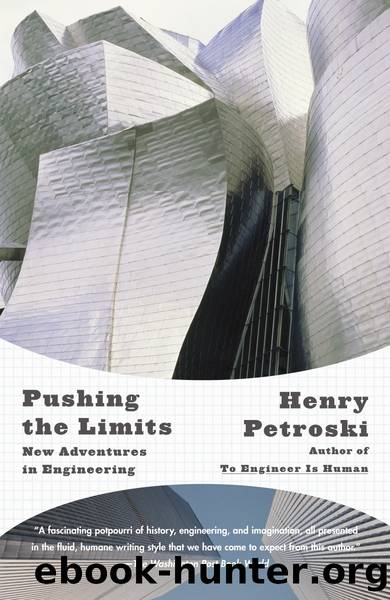Pushing the Limits by Henry Petroski

Author:Henry Petroski
Language: eng
Format: epub
Tags: Nonfiction
ISBN: 9780307427366
Publisher: Knopf Doubleday Publishing Group
Published: 2007-12-18T00:00:00+00:00
Dorton Arena
Among the honors that the structure soon received were the Engineering Gold Medal of the Architectural League of New York and the First Honor Award of the American Institute of Architects for 1953. In 1957, it made the AIAâs list of ten buildings expected to exert the most influence on design in the next century. The Museum of Modern Art in New York was among the museums in which a model of the building was exhibited. The immediate, enthusiastic, and unqualified architectural success of the livestock-judging pavilion led one contemporary critic to ask, âWhy, in this land of the engineer, are there so few frank expressions of integrated engineering that create dramatic architecture?â It was certainly a valid question then, and it remains a valid one now.
Dramatic architecture, like dramatic engineering, begins with a creative idea for solving an old problem in a new way. There were plenty of unimaginative livestock-judging arenas located in state fairgrounds around the country, and there were numerous covered riding arenas and sports stadiums that could have served as models for what was needed in Raleigh. Duke Universityâs Cameron Indoor Stadium, fewer than twenty miles away in Durham, was just one example right in the area. Indeed, many architectural and engineering problems are solved by adapting existing solutions with minor modifications, often without regard to the unique needs or opportunities of a new site. Matthew Nowicki, by thinking about the problem anew, perhaps using his European experience and training to reach beyond examples to principles, was able to rise to the occasion and propose a truly imaginative scheme. And his inspiration was well served by Stanislawa Nowicki, his widow and collaborator; his friend William Deitrick, the architect; and his friend Fred Severud, the engineer. With the blessing of J. S. Dorton, representing the client, and the sympathetic construction skills of William Muirhead, the contractor, Nowickiâs dream was realized. The formula for dramatic engineering and architectural achievement is on one level simple, then: Just recognize a brilliant idea when it occurs, and preserve it through the long and arduous process of making it a reality.
When it opened, the fairgrounds pavilion that was built âto serve agriculture, industry, and commerceâ was officially and unpretentiously named the State Fair Arena. Unofficially and unappreciatively, it was referred to as the Cow Palace. While under construction, it had been called âa flying saucer anchored to a glass platformâ and shortly after its opening a âparabolic pavilion.â But from the start it was also recognized among professional architects and engineers as âthe most important building in America today.â
In 1961, at the opening ceremonies of that yearâs fair, the building was renamed the J. S. Dorton Arena, in recognition of the longtime manager of the North Carolina State Fair, who had recently died. The building was placed on the National Register of Historic Places in 1976, a considerable honor for a structure barely a quarter century old. In 2002, just as it reached the half-century mark, it was named by the
Download
This site does not store any files on its server. We only index and link to content provided by other sites. Please contact the content providers to delete copyright contents if any and email us, we'll remove relevant links or contents immediately.
Learning SQL by Alan Beaulieu(6209)
Weapons of Math Destruction by Cathy O'Neil(6142)
Digital Minimalism by Cal Newport;(5663)
iGen by Jean M. Twenge(5366)
Sapiens by Yuval Noah Harari(5293)
The Age of Surveillance Capitalism by Shoshana Zuboff(4209)
Elon Musk by Ashlee Vance(4027)
Thing Explainer by Randall Munroe(3877)
Apollo 8 by Jeffrey Kluger(3635)
Future Crimes by Marc Goodman(3532)
The Science Book (Big Ideas Simply Explained) by DK(3233)
Who Can You Trust? by Rachel Botsman(3086)
Infinite Energy Technologies by Finley Eversole(2938)
I Live in the Future & Here's How It Works by Nick Bilton(2934)
The Innovators: How a Group of Hackers, Geniuses, and Geeks Created the Digital Revolution by Walter Isaacson(2831)
Steve Jobs by Walter Isaacson(2830)
Dawn of the New Everything by Jaron Lanier(2737)
Chernobyl by Serhii Plokhy(2497)
Ben Franklin's Almanac by Candace Fleming(2467)
